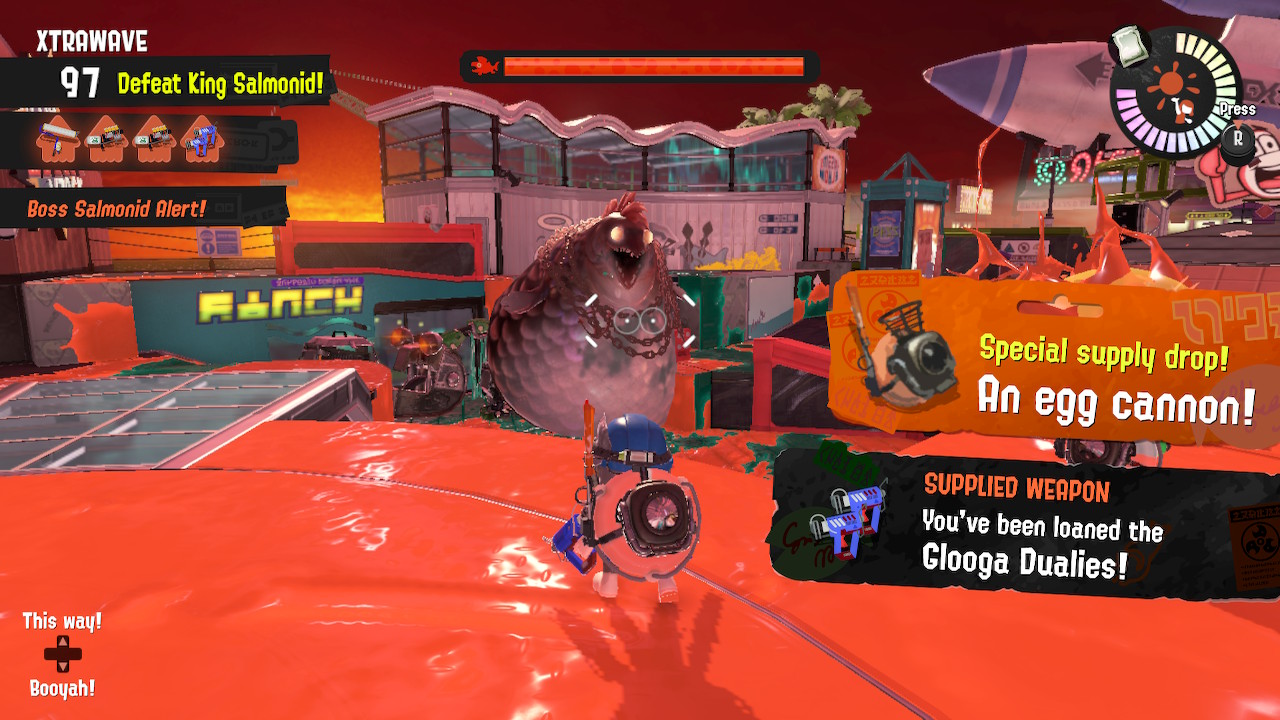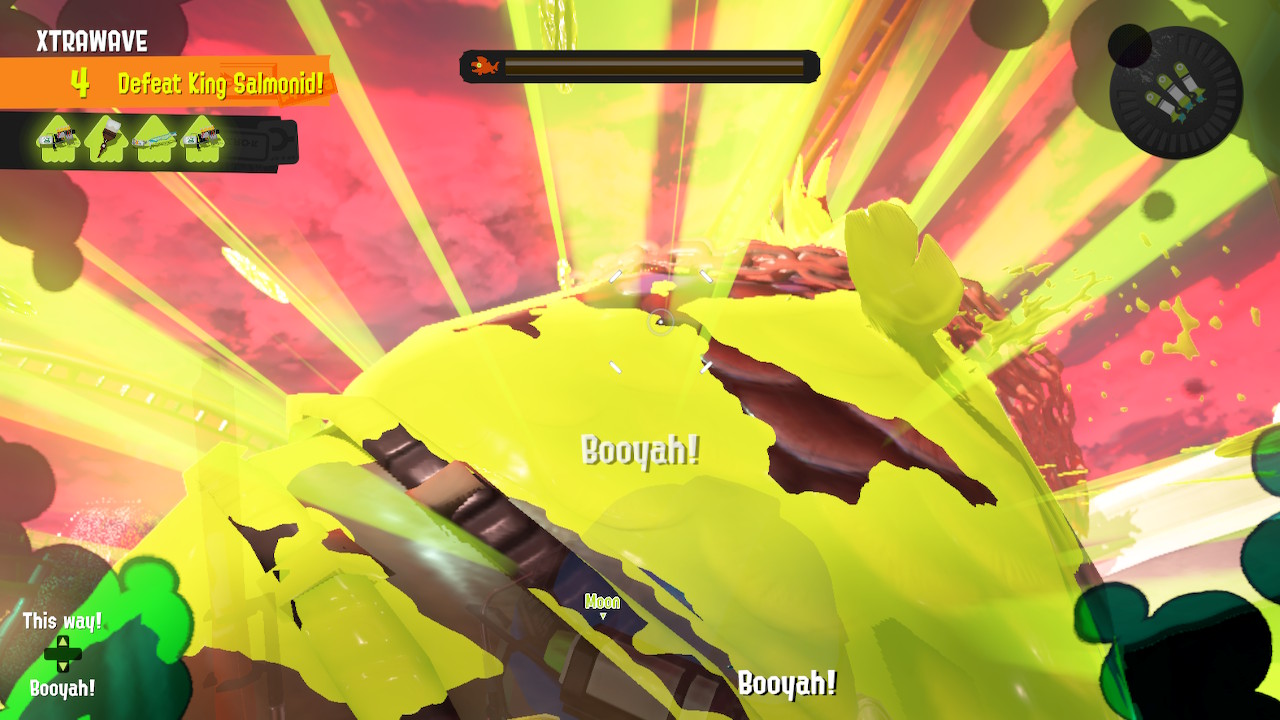
Big Run has run its course in Splatoon 3, and while it was enjoyable, it was no Splatfest. In fact, it felt more like a long, promotional Salmon Run. That in and of itself isn’t terrible until you realize that unless Nintendo has a last-minute announcement to make, Big Runs replace Splatfests on occasion, perhaps every other month from the looks of it.
The good news is that at least Big Run seems to bring back players who have temporarily lapsed, much like Splatfests but specifically for PvE fans, except it’s lighter. There’s no prep period for bonuses, but catalog levels go up faster during the event, as they do during Splatfest, but only for Big Run. Bonus rewards are frequent up to the 2400 mark, unlike on normal days when your capsules get spread out after the 1200 mark, but this basically makes Big Run two Salmon Run map/weapon rotations squished into one weekend-long event, and that’s not great.
Skill checks
To be clear, I enjoyed parts of the event and played longer than needed to for coverage. But I want to call out the designs of this event in relation to some of the reactions I noticed among groups I’m in and some online complaints, and a big part of it comes down to skill.
If we’re talking purely about skill development, Big Run’s good in one area: People have a longer length of time to learn the map. As Big Run uses slightly modified Turf War maps, this is big bonus. Getting a new map is fun, and despite other gamers’ complaints, I actually like Wahoo World. My own group on launch night was all EVPs (the highest rank section) except for me, but they were forgetting some of their basics, like inking walls and going out too far from the group for eggs, just because a map like this has so much going on. That can be fun for some of us, but the Splatoon Run modes are skill checks, and there’s much more to them than maps.
Unfortunately, Big Run also grants nearly any weapon, including rare brand weapons. While it’s great to get three Grizzco Blasters, getting even just two Hydra Spatlings can feel like a jinx. Remember, both Salmon Run and Big Run are gear-agnostic. Salmon Run is an overall weapons skill check just as an entry point. Communication and situational/map awareness are high on the list too, but as someone who sucks at aiming, I can tell you that my groups struggle more any time I’m stuck with a charge-required sniper rifle.
If the weapons pool were limited to four weapons as the average Salmon Run is (as this does occur occasionally in regular Salmon Run as well), players would have more of an opportunity to learn a weapon and its role, allowing the player to improve their play. While the random factor can be fun, the loss of rank can be hard to swallow, especially for players like yours truly who sit on the cusp between casuals and hardcores, and even the latter complained about this phenomenon. This means that even though Big Run is attracting lapsed players, those are also the players who are most likely going to a burden rather than a boon to groups, while lapsed players get one fewer mastery pillar to rely on for success.
Although many gamers called on old friends and connections to try to be within the top ranks to win a special badge and locker decoration, those who are still struggling with the basics can’t exactly be carried to victory, which is admittedly why I didn’t play with the casuals I know. While most PvE encounters are made to be beaten, groups with randoms and underskilled players feel especially unrewarding. It’s not just that the Run mode feels like it promotes static groups and punishes those of us who try to group with randoms or train up new players; it’s that Run mode losses aren’t the 50/50 win/loss that Splatfest and most PvP modes are.
The win spectrum
Much like a full MMO raid, Splatoon Run-modes have a spectrum of “win” depending on the number of waves you beat. Most rounds stop after three, with anything fewer than two completed waves resulting in losing points, which can cost you your rank. That gives you, on average, more to lose than gain, even with the catalog bonus. This is compounded by disconnects, which unlike in Turf Wars won’t let everyone get off the hook or make anything easier, as obviously PvE mobs won’t DC. The game may have felt more stable, but between the punishment of losing a disconnected player and having a spectrum of ways to lose, I saw the initial Big Run rush die only hours after it began.
For those of us who played the whole weekend or were chasing high scores, the loss punishment got worse when factoring in the Cohozuna Meter, which fills after each Run regardless of success. Only upon completion of the third wave does the game take all players’ meters into account and decide whether or not to trigger the fourth wave. A DC here can be heartbreaking, as those with a static group lose out on an encounter and its rewards even though they helped create it.
The fourth wave is also the only way to get Fish Scales, which were sadly not boosted for Big Run. Scales are the currency you use to buy new suits, banners, and other cosmetics (again, nothing will increase arbitrary stats in either Run mode). As rewards for Runs via capsules spread out more and more after reaching 1200 points in Salmon Run or 2400 in Big Run, the game essentially pushes players back towards the PvP modes, apart from the chance to trigger that fourth wave. This makes losing even more painful for those of us who just want to finish off their meter and “go home” to the other mode, aside from players trying to make the Big Run high score.
Getting the big one
This isn’t to say that Splatfest on the whole is equally rewarding the whole time. The Turf War benefits are also best at the start, but you always get cash, XP for levels, XP for gear, and a major discount on scrubbing the Splatfest shirt for ability chunks. Salmon Run gives none of this through basic play. Only through the prize capsules can you get large sums of money, new gear, ability chunks, or food drink tickets, which as noted, get harder and harder to obtain the longer you play.
To note, though, all of these prizes are usable only for the PvP modes, aside from cash that can be used for locker decorations or using the Shell-Out Machine, which also largely gives PvP rewards. Splatfest gives conches for the machine every time you rank up your “battle pass” catalog, not just during the Fest proper but in the lead-up event. Big Run does no such thing. While PvP often gives rewards that can help PvE, this isn’t true in Splatoon 3, but oddly, PvE feels like the harder, more exclusive mode.
Big Run only highlights this issue. While Turf War is fairly accessible and only asks that you be better than other players, Run modes use AI as a skill check. Losing to bots never feels good. While some of the tougher scenarios (Mudmouths, goldie seeking, tornado, and cohock charge requiring canons) aren’t in Big Run at the moment, there are still tons of challenges. Glowflies still feel chaotic, especially if you’re stuck in the middle basket area where there’s no good choke point. Grillers (which may be slowed by zig-zagging) can cause mass panic that kills allies as the target forgets to use walls and gaps to make safe paths. There’s a reason I made a guide prior to Big Run: Run modes aren’t as accessible as Turf War.
Big Run didn’t bring extra fish scales, new gear (a single decoration and badge for the top 5% literally affects only the top 5%), or even bragging rights for being on the winning team in a pop-culture paint war. While PvE players can contribute during Splatfest to the overall team they join, there’s no equivalent for Big Run. And unlike in Splatfest, participants don’t get Super Snails either. It’s odd that a co-op PvE event seems to divide the community more than the PvP one somehow.
As it stands, Big Run should’ve been an interlude event, not a Splatfest replacement. Getting a big new level is fun, as is the initial rush to organize among friends and tackle the new mode. It very much appeals to people who already like Salmon Run and those who are patient enough to have invested in a group.
However, unless you’re a high-end player or very competitive and chase high scores, Big Run can be a big bummer. Nintendo should probably tweak the difficulty levels to make it more consistent or even slightly easier, add on some bonuses (like more Fish Scales or Super Snails), give a few more prizes (like new suits or suit variants with event stickers, tweak (or get rid of) ranks unless adding a non-ranked mode, or just release the mode slightly more often. Big Run just isn’t as accessible or inclusive as even Splatfest, which itself was hardly perfect to begin with.
 Massively OP’s Andrew Ross is an admitted Pokemon geek and expert ARG-watcher. Nobody knows Niantic and Nintendo like he does! His Massively on the Go column covers Pokemon Go as well as other mobile MMOs and augmented reality titles!
Massively OP’s Andrew Ross is an admitted Pokemon geek and expert ARG-watcher. Nobody knows Niantic and Nintendo like he does! His Massively on the Go column covers Pokemon Go as well as other mobile MMOs and augmented reality titles!

















